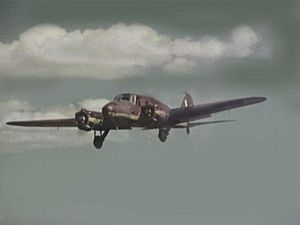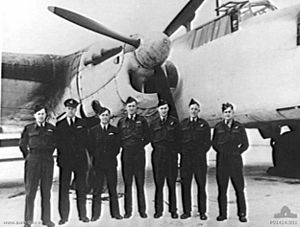No. 612 Squadron RAF facts for kids
Quick facts for kids No. 612 (County of Aberdeen) Squadron RAuxAF |
|
|---|---|
| Active | 1 June 1937 – 9 July 1945 10 May 1946 – 10 March 1957 1997 – present |
| Country | |
| Branch | |
| Role | RAF Medical Reserves |
| Part of | Royal Auxiliary Air Force |
| Base | RAF Leuchars |
| Nickname(s) | County of Aberdeen |
| Motto(s) | Latin: Vigilando Custodimus (Translation: "We stand guard by vigilance") |
| Commanders | |
| Honorary Air Commodore | Sir Ian Forbes-Leith (48–57) Finlay Crerar (57-present) |
| Insignia | |
| Squadron Badge heraldry | In front of a trident and a harpoon in saltire a thistle dipped and leaved The trident and harpoon point to the squadrons anti-submarine role, while the thistle signifies its ties with Aberdeen |
| Squadron Codes | DJ (Jul 1939 – Sep 1939) WL (Sep 1939 – Aug 1943) 8W (Jul 1944 – Jul 1945, 1949 – Apr 1951) RAS (May 1946 – 1949) |
No. 612 Squadron RAF is a special unit of the Royal Auxiliary Air Force (RAuxAF). It was first created in 1937 to help the army from the air. During World War II, it flew planes to scout and find things. After the war, it became a fighter squadron. Today, it helps people by providing medical support for the Royal Air Force.
Contents
The Story of No. 612 Squadron
How the Squadron Started
No. 612 Squadron RAF began on June 1, 1937. It was formed at RAF Dyce in Scotland. At first, its job was to work with the army. The squadron used small, two-seat training planes called Avro Tutors.
Later in 1937, they got Hawker Hector planes. These were also two-seaters and helped the army. In July 1939, the squadron changed its role. It became a "General Reconnaissance" unit. This meant they would fly planes to look for things, like enemy ships. For this new job, they received Avro Ansons. These planes had room for four crew members and could fly much farther.
World War II: Flying Reconnaissance Missions
When World War II started, No. 612 Squadron was part of RAF Coastal Command. Their job was to patrol the seas and look for enemy submarines or ships. They used their Avro Ansons for these important missions.
In November 1940, the squadron started using bigger planes called Armstrong Whitworth Whitleys. These planes were better for long patrols over the ocean. By November 1942, they began to switch again. This time, they got special versions of the Vickers Wellington plane. These Wellingtons were designed for reconnaissance. The squadron flew these planes until the war ended. No. 612 Squadron was officially stopped on July 9, 1945, at RAF Langham.
After the War: From Fighters to Medical Support
No. 612 Squadron was started again on May 10, 1946. It was based at RAF Dyce and became a fighter squadron. They first flew Spitfire planes, which were famous fighter aircraft. In June 1951, they upgraded to jet planes called de Havilland Vampire FB.5s.
The squadron moved between different bases, including RAF Leuchars and RAF Edzell. They returned to RAF Dyce later. However, on March 10, 1957, No. 612 Squadron was stopped again. This happened to all other flying units of the Royal Auxiliary Air Force on the same day.
Today: Medical Support for the RAF
In 1997, No. 612 Squadron was reformed once more at RAF Leuchars. This time, it took on a very different role. It became a medical reserves unit. Its job is to provide "field surgical support." This means they help set up and run medical facilities in places where military operations are happening.
- In 2001, the squadron helped with a big training exercise in Oman called Operation Saif Sareea II. They treated over a hundred military people, mostly for heat-related problems.
- In 2003, the squadron was sent to a combat zone for the first time. They supported Operation Operation TELIC in Iraq. Squadron members worked in field hospitals in Kuwait, Cyprus, Basra, and Al Ahmara.
- In 2006, they were sent to Iraq again to help at the field hospital in Shaibah Logistic Base.
- Later, the squadron sent medical specialists to Afghanistan. They helped at the Military Hospital and with the MERT (Medical Emergency Response Team) at Camp Bastion. Their work there was highly praised.
Today, the squadron continues to train and deploy medical experts when needed. They even work with a US Air Force Reserve Medical Squadron for international training.
Squadron Leaders Since 1997
Here are the leaders of No. 612 Squadron since it became a medical support unit:
| 1997 | 2001 | Wg Cdr J Curnow |
| 2001 | 2003 | Wg Cdr H Grant |
| 2003 | 2007 | Wg Cdr W Pugsley |
| 2007 | 2011 | Wg Cdr A M Moodie OBE QVRM AE |
| 2011 | 2014 | Wg Cdr J P Goodall |
| 2014 | 2018 | Wg Cdr A Cowan |
| 2018 | to date | Wg Cdr B M Colligan TD VR |



